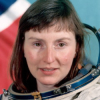Helen Sharman

Helen Sharman
Dr Helen Patricia Sharman OBE FRSCis a British chemist who became the first British astronaut and the first woman to visit the Mir space station in 1991...
NationalityBritish
ProfessionAstronaut
Date of Birth30 May 1963
love
I'd love to go back to space, I don't know any astronaut who doesn't want to.
I would much rather fly on Soyuz than the shuttle.
establish operated tv
I operated a periscopic TV camera so the commander, Anatoly Artsebarsky, could establish where we were heading. It is real teamwork on Soyuz.
physiology suited
I had been lucky that my physiology is well suited to space training.
although classify paid though time tourist
I don't classify myself as the first space tourist because I wasn't as though I paid and had a holiday out of it - although I had a fab time.
definitely
Britain should definitely be part of a Mars mission.
economy government human science useful
The government will see that human spaceflight is useful - for science and the economy - and inspirational.
We should be pushing our boundaries. After all, we Britons are explorers and adventurers.
human science worth
You don't go into space just for the science. Economically, it is not worth it. I think the reason we should be in space is for the exploration; it's the human endeavour.
developed kept
On Mir, the lights kept going out because it had developed so many electrical problems.
deal food
Just because I'm a woman does not mean I have to deal with everything to do with food.
however mars morally people seriously surely trip
Is a one-way trip to Mars ever really seriously going to happen? Surely that's morally reprehensible. However old people are, however much they say they want to go on a one-way mission, people should be thinking about the possibility of returning.
dawn earth faster lightness meant periods towards
Because we were orbiting the earth faster than earth spins on its axis, we went around the earth 16 times a day, an earth day, which meant 16 periods of lightness and 16 periods of darkness in 24 hours. Every so often you'd look towards the earth, and often you could see lightness and darkness together, and dawn and sunset were spectacular.
astronauts eaten lettuce produced station taken
While we've taken seeds into space, and astronauts on the International Space Station have eaten lettuce they've grown, we haven't produced fruit in space, so we can't pollinate something.